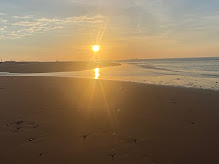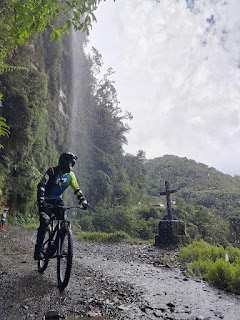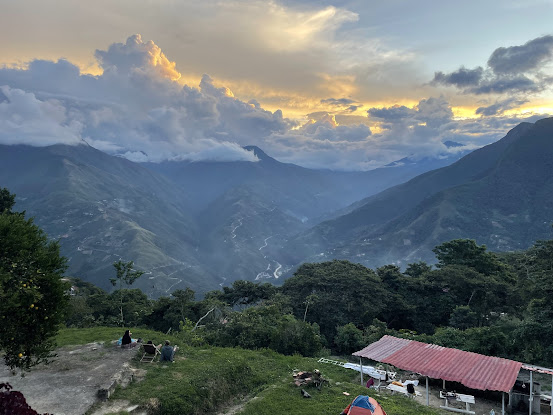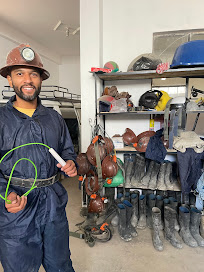May 2, 2024 - View of the Death Road from Coroico, Bolivia
After a few down days, it was then a 3-hour winding mountain minibus back to La Paz with barely enough time for my stomach to settle before we hopped on an overnight sleeper bus to head to the REAL capital of Bolivia, Sucre. A beautiful white colonial city, there are not so many tourist things to do there, which was fine for us because it gave us a breather from the go, go, go. Our time in Sucre was pretty relaxed, getting some bookings done for the coming tours, partaking in the nightlife, and enjoying the beautiful white-washed architecture. Johnny definitely could've spent more time there, but now we had an Amazon tour booked for Peru and our Bolivia trip suddenly had a deadline to work from, so it was off to the next stop.
Our next stop of Potosi has got to go down as one of the most fascinating stops of the trip, not because of the views or the things to do, but because it was another reminder that you just don't know what you don't know. This has got to be one of the most historically significant cities in the world that nobody knows about. Potosi is home to Cerro Rico, the largest silver deposit ever discovered, as well as the funding of Spanish colonialism of the world. They say 80% of the world's silver came from this hill and that you could build a bridge from Potosi to Spain with the silver that was taken from the mountain. Unfortunately, they also say you can build a bridge back with the bones from the 8 million slaves that died taking that silver out of the mountain. There is some controversy with the mine tours there, so I spent hours researching the most ethical companies that best supported the community. I was happy with the tour company I chose, however, the ethical aspect also meant that tourists weren't allowed to detonate dynamite like the large-scale touristy companies. I did feel like I let Johnny down since he had heard from the 19-year-old German hitchhiker we picked up in Patagonia that you could "throw dynamite down mines" and I did not deliver on that promise. Oh well, we lived another day with all limbs intact.
This is where I may as well interject regarding the title of this post; we had heard during our time in Patagonia that Bolivia was the "wild west" of South America. We learned quickly from our Swiss companion on the Death Road tour that you should NOT tell Bolivians they are poor (they are very proud people and rightfully so for their amazing country), but there
is a distinct difference between Bolivia and its South American neighbors that surround it (Chile, Argentina, and Brazil). A country that has largely kept its indigenous culture, from language and dress, to religion and traditions, you instantly know you are in Bolivia from the moment you arrive. Cholitas in tiny bowler caps peddling dried llama fetuses, stomach issues from day one, and questionably safe tourist activities instantly set this country apart as a bit untamed from Western tourists' expectations. Sure, we mountain biked down the deadliest road in the world outside La Paz, but I don't know if the "Wild West" feel really hit until we arrived to Potosi. There, the gloves came off. Staring with our walking tour (in which the time was changed twice), we were led into the city library and a book, pulled from a pile on the bottom, was plopped in front of us and casually flipped through. I was amazed at how old the book looked. Then our guide explained this was a Latin Bible from 1698 brought from Spain to Potosi for the conquistadors. 1698. The US was founded in 1776. I was casually touching a book that was almost 80 years older than my country. I actually asked the librarian why they didn't have it protected behind glass and her response was to point at the pile of equally old books and say "There are too many". My heart almost stopped when this 326-year-old book was casually placed back in its pile on the ground. We noted on the exit the glass shelves displaying suggested reads of the librarian. Glass shelves that could be used to house their antique conquistador collection.... I think it is best summarized by an older Swiss man that we met in Sucre. He had moved to Bolivia over 20 years ago to marry a Bolivia woman he had met while backpacking way back when, so he had a unique perspective of an expat, really one of the only we met on our time in the country. He said, "If Indiana Jones was real and alive today, he would absolutely be in Bolivia.You can still do anything here."

After Potosi would be the big banner destination which is thee reason many tourists come to Bolivia, the very Instagramable Uyuni Salt flats. This was another turn where I had an immense appreciation for all the work Johnny had done during this trip. Trying to find a tour company was literal hours of research. There are dozens of dozens that require price comparisons, reading reviews, cross-checking itineraries, checking community contribution and ethical scores, and emails and WhatsApp messages back and forth. After all that, I found a company I felt good about and we were about to embark on one of the top "must-see before you die" destinations in the world. Things, however, did not go exactly as planned when our tour operator showed up at our hotel the morning of saying that we needed to push the tour until the following day. The reason? Some of the folks that would make up part of our group were sick. We could've tried to find another company to stay on schedule, but after all the research I had done I didn't want to just get stuck with whoever had space at the time. So we had an unexpected down day in Uyuni, a dry, sandy, beige town with an interesting mix of local life and one colorful street they had set aside for the tourists.

So a day late, we started our 3-day tour of Uyuni and a few other natural wonders near the Bolivian/Chilean border. Our group consisted of 4 other backpackers from England and Germany, and although there was a big age gap (the youngest was 19), we had a great dynamic and a fantastic tour. Oftentimes, tourists need to decide whether they will visit the salt flats when there is an inch or two of standing water during the rainy season to get the cool mirror effect you see all over social media, or the dry season when you can drive across the flats and access more areas, like the Incahuasi Island with huge cacti thousands of years old. There are, however, just a few weeks a year where you get both, and we just happen to luck out. There was just one area of water left, but it was enough for us to get the experience of the giant mirror. The whole time you're there, it is pretty otherworldly, with the salt stretching as far as the eye can see. It feels, sounds, and looks like you are walking on slushy snow that has been refrozen. The salt crunches under your feet and it's only when you look close that you realize that all that white is in fact crystals. There are parts of the flats that are meters and meters deep with salt which can actually be cut from the ground and used as building blocks. Our hotel the first night was constructed of salt, including the floors that were pits of salt rock crystals.




Besides the actual salt flats and the Incahuasi Island, we also saw the flamingos of the Laguna Colorada (colored lagoon), the geysers of Sol de mañana, the Dali desert, the valley of the rocks, and a nighttime soak in Polques hot springs. And of course what modern-day group tour would be complete without a few photo shoots. I generally find all that pretty cheezy, but the salt flats do offer up some fun opportunities to play with scope and perspective. I can't even post half the photos I want without this blog taking up 20 pages, we saw so much in 3 days.




The other members of our group branched off the last day into Chile, giving Johnny and me a private tour on our 6-hour drive back to Uyuni, filled with crazy rock features and green valleys full of llamas. Without much time to reflect on the experience, we needed to hop on an overnight bus back to La Paz as soon as we got back to town. It's always nice coming back to a place you've already been because you know what neighborhoods you like and where you want to hang out. Our main purpose for returning to La Paz was to hike in the Valle de las Almas (valley of the Souls), but we went ahead and took 3 nights in the city knowing already it was a place we enjoyed. It was there at an English pub one evening that I discovered I needed an additional teacher certification test as soon as possible, so unfortunately my time in La Paz was overshadowed by a 2-day cramming session. I did still do the hike though, a valley about 30-45 minutes outside of the city center, flagged on both sides by crazy rock formations that are said to be trapped souls.

Hike accomplished, we hopped a bus to what would be our very last stop in Bolivia, Copacabana (yes, like Rio de Janeiro) located, not in Brazil, but on the shores of Lake Titicaca. Bolivia gave us yet another Wild West moment during our bus ride when we hit a strait of the lake that required a water crossing. As the bus lined up for its turn to cross, the bus driver yelled for everyone to get off. Only about half the people complied, leaving me very confused. This is just one time where my Spanish, as bad as it may be, has come in pretty handy. He explained that we needed to get off the bus and buy a ticket for the passenger ferry across for safety reasons and he would get us on the other side. Not entirely sure of what was happening, we complied and bought our 2 Bobs (yes, the Bolivian money is called Bobs) tickets across. As our little passenger boat putted across with some other passengers from our bus, I looked out to see our giant full-sized tourist bus bobbing across the water on what I would describe as a very minimalist ferry boat. I asked the Cholita onboard with me why everyone didn't get off and she explained that there is a law that you can't ride across in a vehicle for safety reasons but many people take the risk to save the 25 cents on the passenger ferry. We crossed and offloaded well before our bus, allowing us to get a snack and wait for it to come around and pick us up. When we reboarded, the driver said in Spanish (with a tone of pride) "You understood very well!" Leading me to believe that I wasn't the first Gringa to be a bit confused by the whole ordeal. When we were back in our seats, the other clearly Western tourist couple that didn't get off the bus explained they didn't understand and had a nervous journey across as the big bus bobbed side to side in the crossing. Oh, Bolivia.
Lake Titicaca was one of those places I had heard of before but didn't actually know where it was located. Well, turns out it's half in Bolivia and half in Peru. Or 60/40 for each side, depending on who you ask. Our first morning there I threw Johnny out of our hotel room to take my biology test that I had only 2 days to study for and found out instantly upon completion that I had aced it. The rest of the day was spent celebrating with "happy hour" (side note: much of what many South American countries call Happy Hour is actually all day 2 for 1, so it's easy to get carried away). I think we both celebrated a bit too much, but it was up bright and early the next day for a hike of Isle de Sol, said to be the birthplace of the first Incas.
We took a two-hour slow ferry to the Northern island town of Challapampa, then hiked the 3 hours South to the town of Yumani to catch an afternoon ferry back to the mainland. There are some Inca ruins to explore, and you have an almost constant view of both sides of the island and the expansive lake as you traverse the ridgeline. And although we haven't bought many souvenirs throughout this trip, with an end date in mind the the extra space I had in my bag from cutting the fat on my last trip home, I finally broke and bought an alpaca sweater from a lady on the island. No regerts, as the pure alpaca sweater only set me back about $17, as opposed to the $70+ you'd pay for something similar in the States. Plus, it's been COLD. Bolivia generally does not seem to believe in climate control, aka heaters, and extra layers will definitely be put to use as we move further into the Southern Hemisphere's winter. But don't let the temperature fool you, because even a short time outside at such high altitudes has resulted in some gnarly sunburns.

May 20, 2024 - Village of Cochabamba on the Isla de sol on Lake Titicaca.
After 24 days, our time in Bolivia was done, and although we had to skip a few places, such as Cochabamba and Santa Cruz de la Sierra (the Miami of Bolivia, whatever that means) because of general visa timeline confusion. You see, the US is one of, if not the only, country that has to pay for a visa into Bolivia, and at $160, it's been our most expensive visa to date. We heard several versions as to why we're special, but they all basically boil down to some bad blood between our countries. Fair. However, the visa that occupies a whole of my passport page clearly says 10 years, even though all state information says 30 days? Unwilling to risk it and with an Amazon tour booked for Peru, it was just about time to exit Bolivia and say "hola" to country #23, Peru.
Overall, we enjoyed our time in Bolivia. It was crazy cheap and the people friendly, although I will say that we were plagued with more stomach problems here, maybe because of how much Johnny enjoyed the local markets. Thinking back on it, neither of us can actually remember meeting a single other American during our time here, which makes it feel like a bit of a lost treasure. Perfect for Indiana Jones.































Comments
Post a Comment